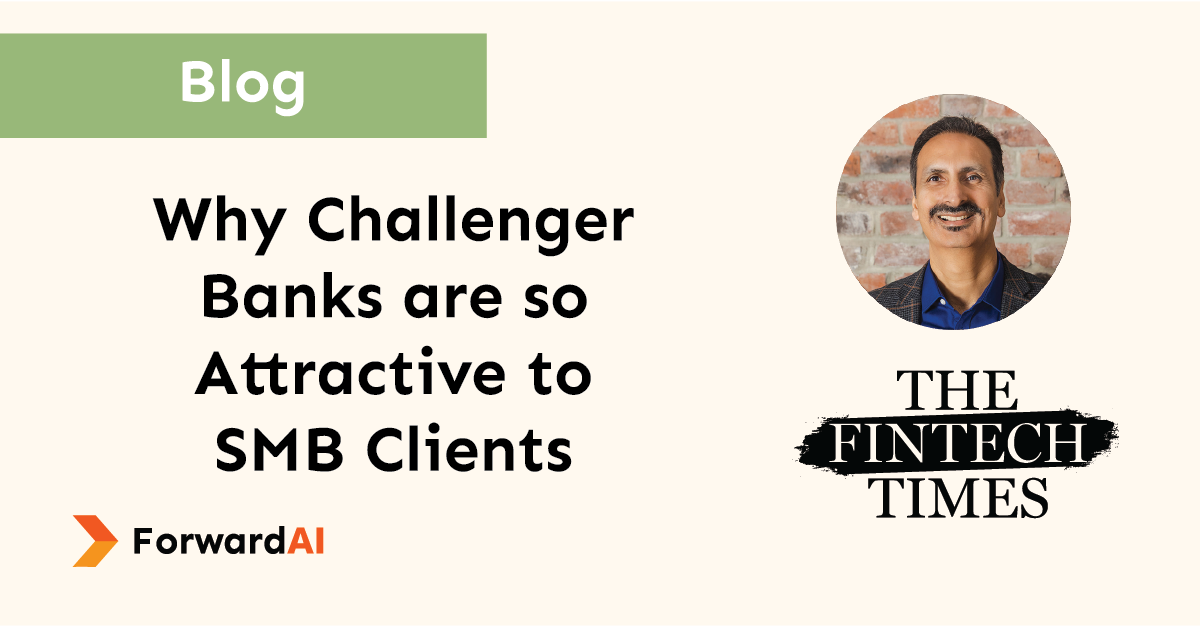Why Challenger Banks Are So Attractive To SMB Clients

Originally published on The Fintech Times.
The traditional lending process lacked flexibility but lenders today can make quick underwriting decisions confidently with APIs that provide access to real-time information and in-depth analysis. Flexible loan terms and repayment options are ensuring challenger banks are primed to meet SMB clients’ needs.
Nick Chandi is the CEO and co-founder of ForwardAI, which provides access to aggregated accounting, financial, and business data for banks, lenders and fintechs. Solutions available include the Precise API, the Access partner portal, and the Predict as a Service client-facing cash flow forecasting and planning tool.
Before co-founding ForwardAI, Chandi co-founded SlickPie, which provided online accounting software for over 40,000 small businesses worldwide. Here he discusses why challenger banks are so attractive to small and midsize businesses (SMBs).
For many small business owners in North America, the thought of securing a bank loan is a fantasy. Traditional underwriting practices, such as redlining and credit scoring, have led to inequality and distrust in how marginalised groups access capital.
In fact, from 2019 to 2020, 63 per cent of employer firms didn’t apply for financing. Out of the nonapplicants, 47 per cent needed funds but chose not to apply, with many listing factors such as low credit score (33 per cent) and too new or insufficient credit history (23 per cent) discouraging them from applying for financing at all.
Credit invisibility has widened the gap of discriminatory lending. Visible minorities and marginalised people are often eliminated from the credit score model due to a lack of credit history and remain credit invisible.
As higher standards for technology are common coming out of the pandemic, some challenger banks are quickly grasping onto growing opportunities to serve these ‘credit invisible” segments. In Canada alone, this includes 35.3 per cent of the population.
Trust in challengers
As a result of the disparity in credit accessibility, many SMBs are moving away from approaching traditional lenders and finding their trust with alternative lenders including challenger banks. These new-age lenders are often smaller and technology-savvy, designed to quickly change internal processes to combat societal issues and compete with well-established institutions.
To tap into underserved markets and safeguard themselves from the growing threat of more agile competitors, traditional lenders need to start embracing innovative fintech solutions. Leveraging tech that brings different data and insights enables alternative lending models – such as cash flow-based lending – and helps traditional lenders capture and retain borrowers otherwise denied.
Many challenger banks already look to data not currently represented in credit scores (such as future cash flow, revenue streams, or financial trends) to create better lending solutions. These lenders eliminated the dependence on historical data by assessing real-time information instead: data that fully reflects a borrowers’ current financial health.
The results? Preliminary research suggests that using alternative data has led to a staggering 60 per cent more loan approvals. Although the lending industry has yet to witness the full impact, alternative lending models are undoubtedly helping lenders thrive and making capital more accessible.
Until recently, small businesses’ cash flow analysis and projection had been a time-consuming and expensive task, costing the same for a 50,000 loan as for a 250,000 loan. However, as technology evolves, real-time financial data is now readily accessible. Driven by new technologies like direct accounting and open banking APIs, lenders can easily tap into a potential borrower’s permissioned data and gain instant insights.
Cash flow-based lending
The eligibility of cash flow-based lending mainly depends on the borrower’s future capacity to generate revenue – something not measured in traditional underwriting models. Now, access to real-time financial data and cash flow trends helps lenders see the actual financial health of a borrower. With the move towards alternative lending models we see today, this new data horizon can facilitate cash flow-based lending in unprecedented ways.
In the absence of solid credit history or available assets, cash flow-based lending opens a new frontier for assessing borrowers’ credibility. Underwriters can determine a borrower’s ability to pay back using real-time accounting and banking data instead of relying on the credit score model. For example, data points such as DSCR, CEI, working capital, or forecasted cash flow impact from business scenarios such as loans or staff hires; all can be used to assess and approve borrowers previously labelled as subprime or high-risk.
More importantly, cash flow-based lending streamlines the underwriting process and helps lenders make quicker and fairer decisions. The credit score model measures factors such as payment history, the total amount owed, length of credit history and types of credit availed. However, not everyone has access to what could reflect their ‘credits’ as borrowers.
Cash flow-based lending removes this barrier by letting lenders quickly review borrowers’ ability to pay back beyond their credit scores. It promotes fair decision-making grounded in data and insights instead of intangible credit practices.
Cash flow-based lending also presents an opportunity for lenders to offer customised loans. By taking a personalised approach using real-time data and event thresholds, lenders can provide ideal loans at the perfect time to clients. Flexible loan terms and repayment options allow challenger banks to exceed SMB clients’ needs instead of the ‘one-size-fits-all’ approach, making these competitors an appealing option compared to traditional institutions.
Moving towards a modern lending experience is critical for any lender looking to make their services more approachable. Alternative lenders aren’t afraid to use new tech and tap into underserved ‘credit invisible’ segments. Traditional institutions need to start innovating and adapting to new standards; expectations are only growing. The modern client won’t wait for older companies to catch up if the services they desire are offered by someone else.
Originally published on The Fintech Times.


